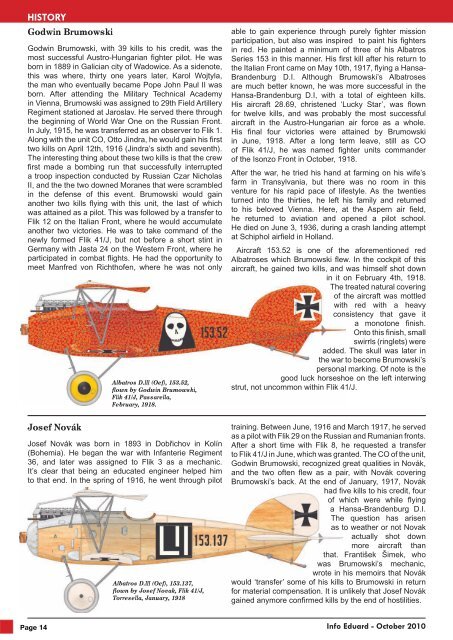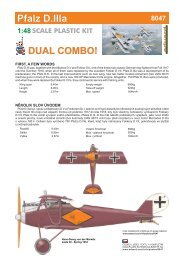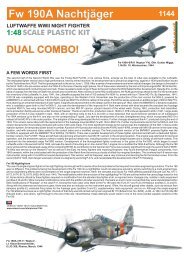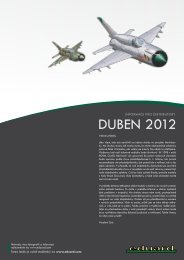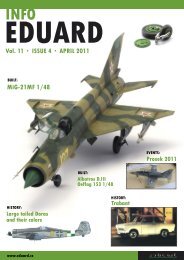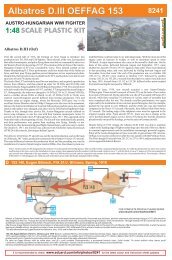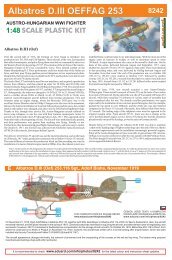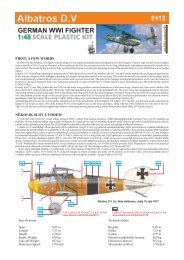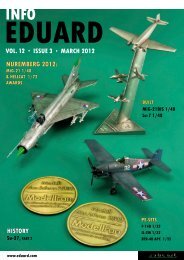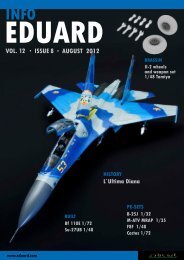You also want an ePaper? Increase the reach of your titles
YUMPU automatically turns print PDFs into web optimized ePapers that Google loves.
HISTORIE HISTORY<br />
Godwin Brumowski<br />
Godwin Brumowski, with 39 kills to his credit, was the<br />
most successful Austro-Hungarian fighter pilot. He was<br />
born in 1889 in Galician city of Wadowice. As a sidenote,<br />
this was where, thirty one years later, Karol Wojtyla,<br />
the man who eventually became Pope John Paul II was<br />
born. After attending the Military Technical Academy<br />
in Vienna, Brumowski was assigned to 29th Field Artillery<br />
Regiment stationed at Jaroslav. He served there through<br />
the beginning of World War One on the Russian Front.<br />
In July, 1915, he was transferred as an observer to Flik 1.<br />
Along with the unit CO, Otto Jindra, he would gain his first<br />
two kills on April 12th, 1916 (Jindra’s sixth and seventh).<br />
The interesting thing about these two kills is that the crew<br />
first made a bombing run that successfully interrupted<br />
a troop inspection conducted by Russian Czar Nicholas<br />
II, and the the two downed Moranes that were scrambled<br />
in the defense of this event. Brumowski would gain<br />
another two kills flying with this unit, the last of which<br />
was attained as a pilot. This was followed by a transfer to<br />
Flik 12 on the Italian Front, where he would accumulate<br />
another two victories. He was to take command of the<br />
newly formed Flik 41/J, but not before a short stint in<br />
Germany with Jasta 24 on the Western Front, where he<br />
participated in combat flights. He had the opportunity to<br />
meet Manfred von Richthofen, where he was not only<br />
Josef Novák<br />
Page <strong>Info</strong> 14<strong>Eduard</strong><br />
- říjen <strong>2010</strong><br />
Albatros D.III (Oef), 153.52,<br />
flown by Godwin Brumowski,<br />
Flik 41/J, Passarella,<br />
February, 1918.<br />
Josef Novák was born in 1893 in Dobřichov in Kolín<br />
(Bohemia). He began the war with Infanterie Regiment<br />
36, and later was assigned to Flik 3 as a mechanic.<br />
It’s clear that being an educated engineer helped him<br />
to that end. In the spring of 1916, he went through pilot<br />
Albatros D.III (Oef), 153.137,<br />
flown by Josef Novak, Flik 41/J,<br />
Torresella, January, 1918<br />
able to gain experience through purely fighter mission<br />
participation, but also was inspired to paint his fighters<br />
in red. He painted a minimum of three of his Albatros<br />
Series 153 in this manner. His first kill after his return to<br />
the Italian Front came on May 10th, 1917, flying a Hansa-<br />
Brandenburg D.I. Although Brumowski’s Albatroses<br />
are much better known, he was more successful in the<br />
Hansa-Brandenburg D.I, with a total of eighteen kills.<br />
His aircraft 28.69, christened ‘Lucky Star’, was flown<br />
for twelve kills, and was probably the most successful<br />
aircraft in the Austro-Hungarian air force as a whole.<br />
His final four victories were attained by Brumowski<br />
in June, 1918. After a long term leave, still as CO<br />
of Flik 41/J, he was named fighter units commander<br />
of the Isonzo Front in <strong>October</strong>, 1918.<br />
After the war, he tried his hand at farming on his wife’s<br />
farm in Transylvania, but there was no room in this<br />
venture for his rapid pace of lifestyle. As the twenties<br />
turned into the thirties, he left his family and returned<br />
to his beloved Vienna. Here, at the Aspern air field,<br />
he returned to aviation and opened a pilot school.<br />
He died on June 3, 1936, during a crash landing attempt<br />
at Schiphol airfield in Holland.<br />
Aircraft 153.52 is one of the aforementioned red<br />
Albatroses which Brumowski flew. In the cockpit of this<br />
aircraft, he gained two kills, and was himself shot down<br />
in it on February 4th, 1918.<br />
The treated natural covering<br />
of the aircraft was mottled<br />
with red with a heavy<br />
consistency that gave it<br />
a monotone finish.<br />
Onto this finish, small<br />
swirrls (ringlets) were<br />
added. The skull was later in<br />
the war to become Brumowski’s<br />
personal marking. Of note is the<br />
good luck horseshoe on the left interwing<br />
strut, not uncommon within Flik 41/J.<br />
training. Between June, 1916 and March 1917, he served<br />
as a pilot with Flik 29 on the Russian and Rumanian fronts.<br />
After a short time with Flik 8, he requested a transfer<br />
to Flik 41/J in June, which was granted. The CO of the unit,<br />
Godwin Brumowski, recognized great qualities in Novák,<br />
and the two often flew as a pair, with Novák covering<br />
Brumowski’s back. At the end of January, 1917, Novák<br />
had five kills to his credit, four<br />
of which were while flying<br />
a Hansa-Brandenburg D.I.<br />
The question has arisen<br />
as to weather or not Novak<br />
actually shot down<br />
more aircraft than<br />
that. František Šimek, who<br />
was Brumowski’s mechanic,<br />
wrote in his memoirs that Novák<br />
would ‘transfer’ some of his kills to Brumowski in return<br />
for material compensation. It is unlikely that Josef Novák<br />
gained anymore confirmed kills by the end of hostilities.<br />
<strong>Info</strong> <strong>Eduard</strong> - <strong>October</strong> Strana <strong>2010</strong> 10


